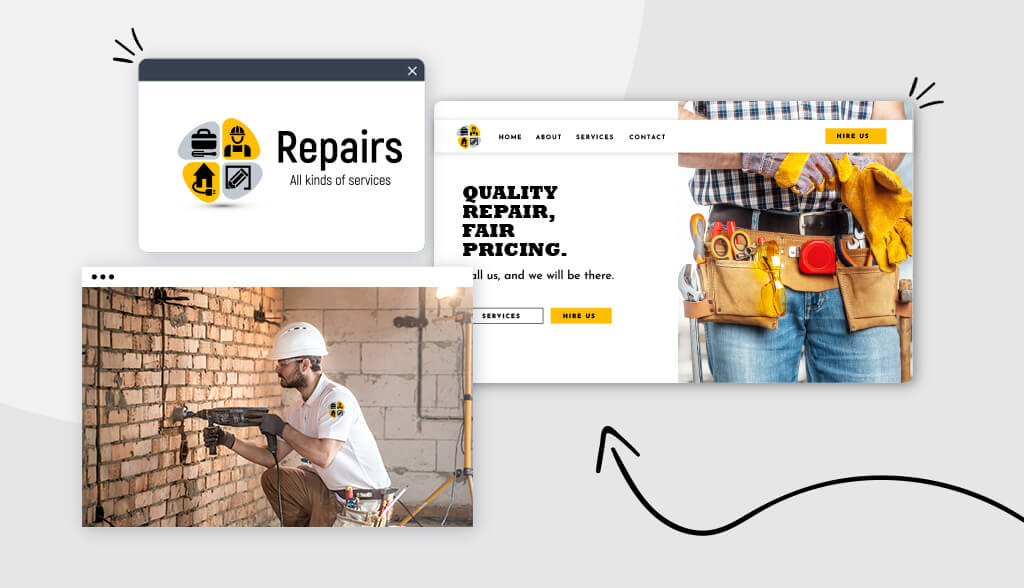Experience is often better than hindsight, as it can save time and money.
So, let’s finish with several ways experienced handymen and women automate their businesses using software, enabling them to take it to the next level:
Automate your work processes
Software solutions such as bookkeeping, invoicing, and client scheduling help automate your business processes so you can work without too many distractions.
Trust me; they sure make life easier.
Apps for bookkeeping
Efficient bookkeeping is essential to running your handyman business, but it can take up precious amounts of your time!
The solution is to use bookkeeping software that helps you track your transactions, log expenses, and share them with your accountant while you work.
2 easy-to-use bookkeeping apps are:
QuickBooks Online
QuickBooks helps you track expenses, upload receipts, reconcile accounts, prepare statements, and view accounting reports from your phone or laptop. At the same time, it conveniently connects with your business credit cards and bank accounts.
Wave
Voted as one of the best free bookkeeping apps for small businesses that need efficient accounting capabilities, Wave covers the accounting basics, including expense tracking, accounts payable, and bank reconciliation.
Wave also syncs with your bank accounts and credit cards and tracks expenses and income from various streams.
Apps for invoicing
Creating and managing invoices is another job that takes time and effort, but you won’t get paid if you don’t do it.
Here are 3 invoicing apps that simplify the process:
Invoice Simple
An easy-to-use invoicing app that sends estimates and invoices to your clients. Invoice Simple lets you track your invoices via the web using their iOS and Android applications.
Invoice Ninja
Offers a free service that enables you to manage 100 clients with unlimited invoices. Some advanced features include auto-billing, time tracking, and branded invoices.
The app also integrates with over 40 online payment gateways and allows you to accept deposit payments.
Xero
With Xero Early plan ($12/month), you can create and send your invoices, reconcile all bank transactions and track your upcoming bills. Handy!
Apps for client scheduling
Scheduling is often the most challenging aspect when starting a handyman business.
For example, if you book 4 weeks ahead and the job you’re on runs over, you might have to reschedule 20 other clients!
That’s why you’ll need a software scheduling system that stores your future clients’ details and lets you contact them all at once.
HubSpot Meetings Tool
HubSpot’s Meetings Tool syncs with Office 365 and Google Calendar, enabling you to display your availability to prospective clients so they can book your services online.
There’s also a form field you can add to your meeting page that collects client contact information, which you can add to your website and receive via email notifications.
Setmore
Setmore is a free scheduling app and payment platform for creating a client booking page. It allows for multiple users and enables you to send appointment notifications and cancellations to customers who booked your service.
Google contact form
The Google contact form connects to your website’s contact page and collects your client’s information. You then use a third-party system (like Zapier) that links to your email, so you see everything you need before meeting a prospective client.
The takeaway is that the more you systemize your business, the easier it’ll be to run it.
Deliver excellent customer care and keep clients
Excellent customer care and client retention go hand-in-hand; here’s how you do both.
Deliver excellent service
Customer service starts when a prospective client contacts your handyman business, and everything you do from that point should focus on retaining them.
Set high expectations early by maintaining regular contact and keep your customers informed of any changes to your schedule.
When on the job, ensure you provide quality work, be as unobtrusive as possible, keep your clients’ property clean, and update them on progress.
When and how to follow up
Clients appreciate a handyperson who makes a call back within a week of job completion, as it shows them you care about your customers and see them as long-term clients.
Callbacks often lead to more work, especially when customers are happy with the original project, and it’s an ideal time to ask for feedback and those all-important reviews on your Google My Business listing, Facebook page, and website.
How to keep your customers loyal
It costs 5 times more to attract new clients than to keep existing ones, so it pays to give your customers a reason to be loyal.
One strategy to build your client list is to provide discounts on additional projects when you start your handyman business.
And as most clients have over one project they need fixing, by offering a small financial incentive, chances are they’ll ask you to do the rest.
How to choose suppliers
Close supplier proximity is vital as it saves you time and fuel costs. So, try using suppliers with multiple locations in your state to have them on hand wherever you work.
And the more you use one supplier, the quicker you’ll get cash-saving tradesman rates.
Know when to expand your team
With your marketing in place, it won’t be long before you tap your ability to make more money alone. When that happens, you could consider hiring someone–such as another skilled handyman, a business partner, or a marketing professional.
Skilled employees can cost you between $25-35/hour, and the most challenging part is finding the right staff.
The key is to hire people with your brand’s core values, train them up and give them the skills they need to get your work done.
Then, have them generate revenue while you work on scaling your business.
Alternatively, choose to outsource
Outsourcing is when you hire another business or freelancer to perform specific tasks, handle operations, or provide services for your handyman business.
Many handyman businesses do this to find skilled people while avoiding the cost of full-time employees.
The most commonly outsourced services for a handyman business are:







